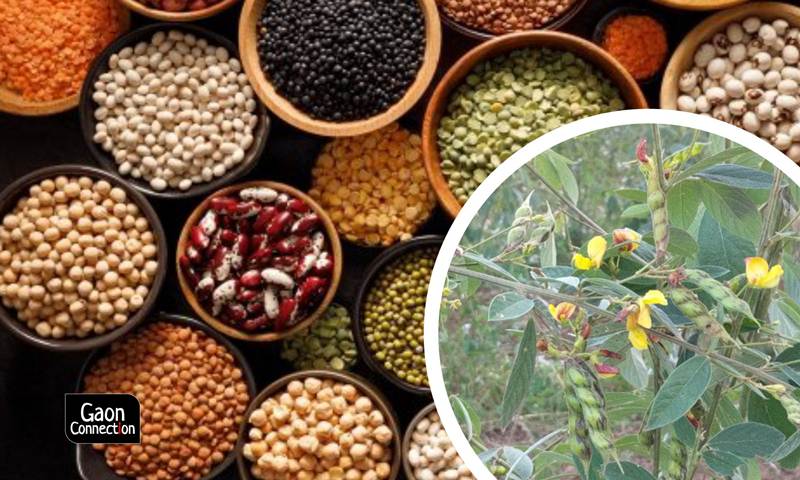In the wake of rising prices of pulses, the central government had approved the import of pulses on March 3 so as to stabilise the prices. Last month, on May 15, the Indian government also removed the import taxes on pulses.
This has not gone down too well with pulse farmers in the country. Almost three months after the decision to import pulses, these cultivators are growing weary of the imported pulses, which they fear will spoil their prospects of securing a profit in the next year. Traders seem unhappy too.
Also Read: Amid bad harvest, Indian Govt approves import of 400,000 metric tonnes urad dal from Myanmar
Pradeep Khandelwal is critical of the Centre’s policy on pulses import and production. “The government expects farmers to get just prices for their produce and also wants consumers to get the pulses at a lower price. How is it even possible?” Pradeep Khandelwal, an Indore-based pulse trader asked.
“If the government wants to feed the consumer at a lower price, pulses should be procured within the ambit of PDS (public distribution system) like wheat and rice. Why should farmers suffer losses?” Khandelwal added.
Last year, Maharudra Shetty, a pulses cultivator from Maharashtra’s Latur district sold his pigeon pea produce at a rate of Rs 6,400 per quintals (1 quintal = 100 kilogrammes). The minimum support price (MSP) of pigeon pea is Rs 6,000 per quintal.
Last year, he had sold it at Rs 5,700 per quintal and the year before at Rs 4,700 per quintal. Shetty is about to begin cultivating for the next season but the apprehension of not being able to get a profitable margin worries him.
Also Read: High food prices worsen citizens’ worries amidst a raging COVID19 pandemic
“I have no complaints about the rate I received for my produce for the last two seasons. But now, since the government has brought in imported pulses from foreign countries, the prices for pulses are bound to go down,” he told Gaon Connection.
“It is expected that the profits for the farmers will be reduced. Even the prospects for profit are dicey. With these worries, I will be sowing a hectare of my field with toor dal after June 15,” he added.
Also Read: Pulses, edible oil, eggs, meat, fish… retail inflation rises to four month high
Shetty cultivates pulses in Ustari village which falls in the Nilanga taluka in Latur. He is a native of the Marathwada region which is known for its prolific cultivation of toor dal (pigeon pea) in India.
Why do high prices in the market don’t translate into better prices for farmers?
Suresh Agrawal, president of Indore-based All India Dal Mill Association, told Gaon Connection that the high prices for the consumers do not necessarily mean higher profits for the cultivators.
“The high prices of the pulses were not reflecting in the farmers’ profits because the price rise was not very significant in the wholesale market. The retail market was selling the pulses at a higher price due to the disruption in the supply chain,” he said.
“If the government wanted to cap inflation, it should have cut down the prices for petrol and diesel. Decision to import pulses is not really beneficial in the long run,” Agrawal added.
“Even now, in the wholesale market, good quality pulses are being sold at Rs 95 per kilogram in the wholesale market,” he told Gaon Connection.
In the retail markets in the national capital, pigeon pea is being sold at around Rs 120-145 per kg. The prices of pulses have soared to almost 30 per cent as compared to the prices in September, last year.
Long-term effect on cultivators
Meanwhile, Sanjeeb Mukherjee, Agriculture Editor of the national daily newspaper Business Standard pointed out that pulses do not sell fast enough for the imported stock to deplete quickly.
“The government has reasoned that the imported stock of pulses will arrive a month or 45 days in advance of the arrival of the stocks of the Indian cultivators. But pulses are not like wheat or rice. It gets consumed at a slower pace. The imported stock is expected to impact the farmers in India for a longer period of time,” he said.
Also, Mohali-based agrarian expert Devinder Sharma told Gaon Connection that the moment farmers begin to get better rates for their produce, some policy decision is taken to bring down the prices of the food commodity to appease the consumers.
“Nobody is interested in incentivising the farmers for their hard work. On one hand the government is striving to become self-reliant in pulses production, on the other hand it is importing pulses,” he said.
Demand, production and import
According to the Indore-based pulses mill association leader, India demands a total of 25,000,000 metric tonnes of pulses per year and the production for this year (2020-21) is at around 21,500,000 metric tonnes.
Pradeep Ghorpade, a senior representative from Mumbai-based Indian Pulses and Grain Association told Gaon Connection that the unseasonal rainfall in September-October last year has been the main reason behind a drop in production this year.
“To meet its domestic demand, India imports pulses from Myanmar, Mozambique, Zimbabwe and Canada. Till May 15 this year, this import was not absolutely free of taxes. But now, the government has removed the import duty to quickly meet its demands,” he said.
Earlier, the duty on chana (black gram) was 60 per cent, for peas it was 50 per cent, and for masoor (red lentil) and pigeon pea, it was 30 per cent.


















